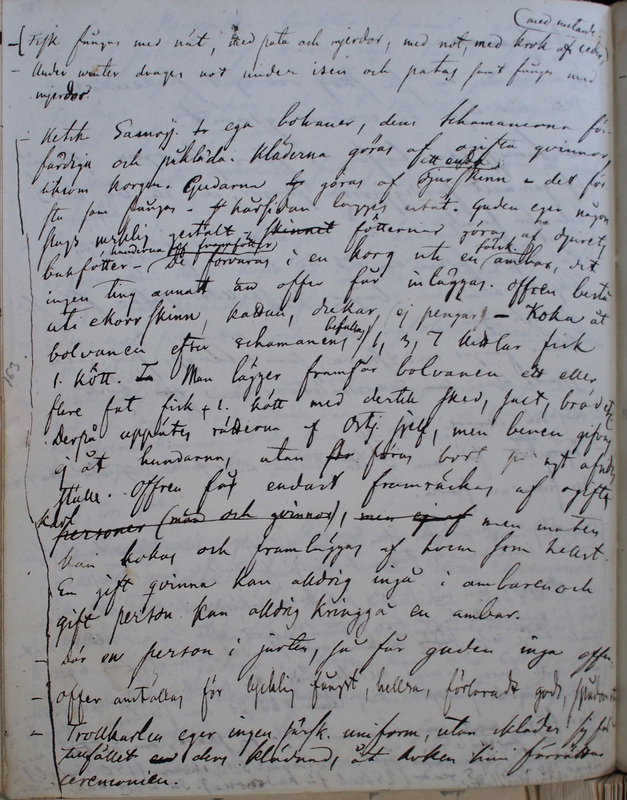Ethnographiska, historiska och statistiska anmärkningar. 230
Title
Ethnographiska, historiska och statistiska anmärkningar. 230
Description
|
Fisk
fångas med nät, med pata och mjerdor, med not, med krok af ceder, med metande.See [fiskafånget].
Under winter drages not under isen och patas samt fångas med mjerdor. Ketska Samojj.[Samojeder] ega bolvaner,
dem schamanerna förAncestor spirits made of wood or metal and with a human shape and often several layers of clothing on them are stored in special storehouses or small baskets or hung in trees. Called generally SE qawa lōsi, their head is named SE kwettargu. (Selkup mythology 2010: 211, 88)
färdiga och påkläda. Kläderna göras af ogifta qvinnor, liksom korgen. Gudarna göras af ett enda djurskinn - det för sta som fångas. Härsidan lagges utåt. Guden eger någon slags msklig[mänsklig] gestalt. Fötterna göras af djurets bakfötter; händerna af framfötter De förvaras i en korg uti en ambar, dit ingen ting annat än offer får inläggas. Offren bestå uti ekorrskinn, kattun, dukar (ej pengar) - Koka åt bolvanen efter schamanens befallng.[befallning] 1, 3, 7 kettlar fisk l.[eller] kött. Man lägger framför bolvanen ett eller flere fat fisk l.[eller] kött med dertill sked, <saet>, bröd etc. Derpå uppätes rätterna af Ostj.[Ostjaker] sjelf, men benen gifvas ej åt hundarna, utan föras bort på ngt[något] <afud> ställe. Offren få endast framräckas af ogifta personer (män och qvinnor) karl, men e j af men maten kan kokas och framläggas af hvem som hellst. En gift qvinna kan alldrig ingå i ambaren och gift person kan alldrig kringgå en ambar. Där en person i jurten, så får guden inga offer. Offer omtackas för lycklig fångst, hellsa, förloradt gods, spådom Trollkarlen eger ingen särsk. uniform,
utan kläder sig förAccording to Donner, a Selkup shaman has a special spoon, cap, breast-piece, boots, drum, gloves, and coat, which they prepare in the above-mentioned order. Additionally, some shamans may use a staff made of iron. The paraphernalia represent the shaman’s power, the extraordinary nature of the ritual, and their helping spirits. The hat, for example, is typically made of iron, the seams of their clothes are sewn differently from everyday clothing, and the costume includes pictures and bones of different animals that represent spirits. See also Selkup shaman paraphernalia in Finna: [Shaman's dress][Shaman's headgear] (Donner 1933: 78–81)
tillfället dess kläderna, åt hvken[hvilken] han förrättar ceremonien. |
Fish are caught with nets, with weir and fish traps, with drag nets, with cedar hooks, and by seine fishing. During the winter, nets are drawn under the ice and weirs and fish traps are also used. The Ket Samoyeds have bolvans, which shamans make and dress. The clothes are made by unmarried women, who also make baskets. The gods are made from a single animal skin – the first caught. The fur side is laid outwards. The god has some kind of human shape. The feet are made of the animal’s back legs, the hands of the forefeet. They are stored in a basket outside a storehouse, where nothing but offerings may be left. The offers consist of squirrel skin, calico, or cloth (not money). Following the shaman’s advice, they cook one, three, or seven pots of fish or meat for the bolvan. They put in front of the bolvanen one or several dishes of fish or meat with a spoon, bread, etc. Then the dishes are eaten by the Ostyaks themselves, but the bones are not given to the dogs, but carried away to some place. The offers can only be brought by unmarried persons, but the foodcan be cooked and laid down by anyone. A married woman can never go to the storehouse and a married person must never go around the store house. When there is a person in the yurt, the god gets no sacrifices. The sacrifices are made in order to give thanks for a good catch, health, lost property, or divination. The shaman has no special clothing, but he puts on clothes to suit the occasion for which he performs the ceremony. |

